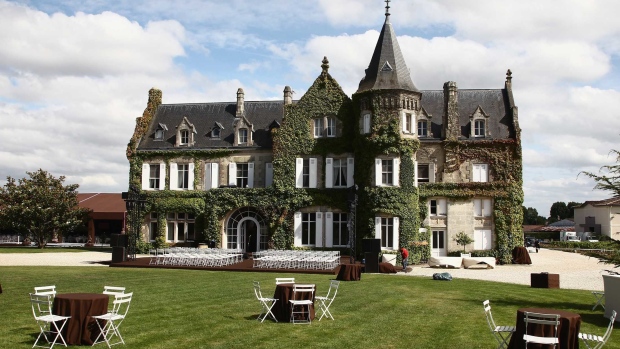Nov 1, 2022
American Gaylon Lawrence Buys Grand Cru Bordeaux Wine Estate
, Bloomberg News

(Bloomberg) -- Gaylon Lawrence, a Tennessee-based billionaire with US farming and banking interests, has been on a wine-buying spree ever since purchasing his first property just four years ago. After snapping up Napa Valley’s iconic Heitz Cellar in April 2018, he grabbed the historic Haynes vineyard in Napa’s Coombsville area and added the equally historic Burgess Cellars and Stony Hill Vineyard.
Now, Lawrence and Carlton McCoy Jr., managing partner for Lawrence Wine Estates, are taking on Bordeaux. On Oct. 31 they announced the purchase of a majority stake in Château Lascombes, a second growth estate in the Margaux appellation with a picturesque but slightly run-down ivy-covered stone chateau. It produces about 20,000 cases a year of a red blend that includes Cabernet Sauvignon and Merlot with a dash of petit Verdot. For an undisclosed price, they purchased the chateau, about 300 acres of vineyards—and an underperforming reputation they aim to change.
In 1855, the chateaux in the Medoc, the area north of the city of Bordeaux that includes Margaux, were ranked in five categories, from the first down to the fifth growths. The first tier includes only five top names, such as Château Lafite Rothschild. Lascombes is in the second tier, with 13 other chateaux. Although there have been some changes over the past 167 years, a chateau’s rank on the famous list confers esteem and influences the market for its wines. “We’re honored to become the new stewards of such an historical estate,” said Lawrence in the announcement.
None of the classification’s 60 crus classés in the Medoc is owned by an American, though the French Wertheimer family, owners of Château Rauzan-Ségla (and Chanel), live in New York City. First growth Château Haut-Brion, in the Graves region south of Bordeaux, was purchased in 1935 by American Clarence Dillon, and remains in the family, run by his great-grandson, Prince Robert of Luxembourg.
The Lawrence family purchased Lascombes from French insurance company Mutuelle d’Assurance du Corps de Santé Français (MACSF), which will retain a seat on the board and continue to hold an interest, but the Lawrence family will have 100% control over operations and strategy, according to McCoy, who spoke with Bloomberg in an exclusive Zoom.
It’s an interesting reversal. Several important Bordeaux chateaux own Napa wineries. Mouton Rothschild co-owns Opus One; Pichon Baron has Outpost; Pontet-Canet has Pym-Rae; Francois Pinault of Château Latour owns Eisele Vineyard. But few Napa producers have bought in Bordeaux. (One exception is American investor and businessman Stephen Adams and his wife, Denise, who first purchased Château Fonplegade in Saint-Emilion and later added Adamvs in Napa.)
How the sale happened
“We’ve become known as a family interested in buying luxury wine assets,” says McCoy, who admits they receive “lots of offers” but turn down 99% of them. They’d considered properties in Bordeaux and Burgundy before, and one in Champagne, but “this was the right time and the right estate.”
The possibility of acquiring Château Lascombes “came in a whisper that it might be available.” They could see it fitting into their Lawrence Wine Estates portfolio, which also includes Demeine Estates, a California-based import and distribution company.
View this post on InstagramA post shared by Château Lascombes (@chateau_lascombes)
And so began conversations and negotiations, including a weeklong visit in July. McCoy and Lawrence brought some of their Napa wines to show Lascombes’ owners their style of winemaking. “They respected our philosophy … and they were flabbergasted by the freshness and complexity of our wines,” says McCoy. They agreed on the vision for Lascombes.
He explains, “We’re realists. Lascombes hasn’t made great wines consistently in recent years. A lot of that had to do with farming. We’ll focus on farming properly and be more meticulous in selection of the plots for the first wine.” The Lawrence Wine Estates group has extensive experience with organic and biodynamic viticulture in Napa and plans to experiment and go slowly in that direction.
Lascombes winemaker Delphine Barboux has been promoted to a bigger role at the chateau, and in the works are new hires for the vineyard and a new chief executive officer. The new owners were fortunate with the character of the 2022 vintage, thanks to amenable weather. It’s the kind of vintage McCoy likes, with, he says, “intensity and density and length, plus fresh acidity.” The blend they craft this winter, which they’ll show as barrel samples at next April’s en primeur tastings, he sees as “critical to establishing Lascombes’ new identity.”
Surprisingly, Americans have featured heavily in the chateau’s recent past. In 1952 it was bought by a group of American investors headed by the wine importer Alexis Lichine, eventually selling to beer company Bass-Charrington. It in turn sold the property for $69 million to another consortium, including American investment fund Colony Capital. MACSF paid $280 million for it in 2011. Lawrence and McCoy are keeping the latest price quiet.
View this post on InstagramA post shared by Château Lascombes (@chateau_lascombes)
These days, Bordeaux is attracting a lot of investment from everywhere. In early October, Treasury Wine Estates Australian flagship Penfolds bought Château Lanessan, after acquiring three cru bourgeois estates in 2021 and two in 2019. In September, California-based private equity firm Younan Co. purchased its third wine domain in Saint-Emilion in three years. But none of the above is a grand, large property like Lascombes.
The sale raises plenty of questions, such as: Will Lawrence start snapping up other Bordeaux properties as quickly as he did in Napa? “We’re open to other buys,” says McCoy. “But we want to focus on Lascombes and setting it up for the next century. I see it very quickly in the next 10 years becoming one of the greatest estates in Bordeaux.”
Will it? I’ll report on its progress during tastings next year.
©2022 Bloomberg L.P.






